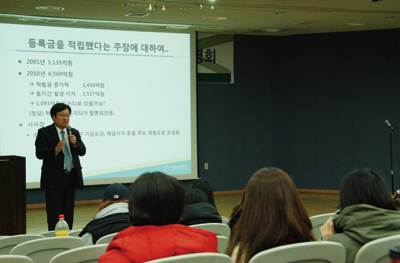The background behind the tuition cut

On Feb. 2, Ewha decided to lower tuition by 3.5 percent for both its undergraduate and graduate students and to offer extended scholarships up to 4.9 billion won. For this feature edition, the Ewha Voice will delve into the background of the fall in Ewha’s tuition, explore details of the benefits students from mixed grade levels can receive, and report the varied opinions amongst students concerning Ewha’s tuition.

To probe further behind the scenes of the tuition cut, the Ewha Voice sat down for an interview with professor Shin Kyung-shik (Business), the vice president of the Office of Financial Affairs.
Before the 3.5 percent tuition cut, there were four Tuition Review Board (TRB) meetings on Jan. 27, 28, 30 and Feb. 1 respectively. The TRB, formed at the end of last year to discuss appropriate school tuition levels, consists of school officials from the Office of Financial Affairs, Office of Planning, and Office of Student Affairs. In total, there were 13 TRB members: six school representatives, six student representatives, and an external auditor. Once the TRB settled the appropriate tuition level, it was approved by the president of Ewha and announced to the public.
However, the student representatives refused to participate in any of this year’s TRB meetings. This happened last year, too, due to four issues which students clashed with the school.
“Some people assume that problems or struggles regarding school tuition are solved when the Student Government Association (SGA) participates in the TRB as student representatives. However, this only grants the school justification for high tuition,” said Jung Na-wee (Sociology, 4), the president of the SGA.
Student representatives first required six seats each for themselves and school representatives, in addition to the right to pick an external auditor.
“Originally, there were four seats for students and school representatives, respectively, and a seat for the external auditor,” Shin said. “We accepted the students’ suggestion on that part. However, we did not understand why the external auditor had to be picked by the students since reviewing the budget objectively is what the auditor does.”
Student representatives and school representatives also failed to agree on whether to make the TRB meetings open to all students or only to the chosen student representatives from each college and major, and whether TRB meetings should have voting rights to set tuition levels.
“We thought opening TRB meetings to 130 delegates from each major and college was enough since making the meetings open to everyone could disturb the progress,” Shin said. “Also, voting on college tuition is not allowed at TRB meetings, as it is the sole responsibility of the president of Ewha.”
At the first meeting on Jan. 27, the TRB discussed rules on maintaining the committee but could not discuss tuition since there were no student representatives. Although student representatives remained absent, three meetings followed since the school had to meet a Jan. 31 deadline to receive government subsidy for scholarships. During the three meetings, there was heated debate on whether or not to increase the tuition.
“When inflationary effects on prices are taken into account, the total budget had to be increased,” Shin said.
But by cutting Ewha’s tuition by 3.5 percent, according to Shin, Ewha’s budget decreased by around 4.6 billion won, meaning the school would have to cut funding for renovations, research projects, and would not be able to save depreciation costs.
The school also realizes the lowered tuition could still be high for students with heavy financial burdens. However, Shin was skeptical about decreasing tuition further by using funds from the Ewha Foundation, which contains about 70 billion won.
“You do not sell your house to earn living expenses,” Shin said. “It is the same case. It would be unfair to use the Ewha Foundation money for only one group of students in this year, sacrificing the amount of money future students should use.”
* Reporter: Yang Su-bin & Jang Youn-hee & Lee Hea-won
* E-mail: subinyang@ewhain.net & janet9106@ewhain.net & heawon_lee@ewhain.net

